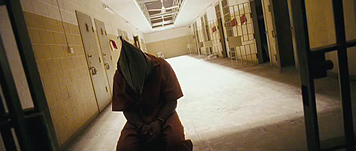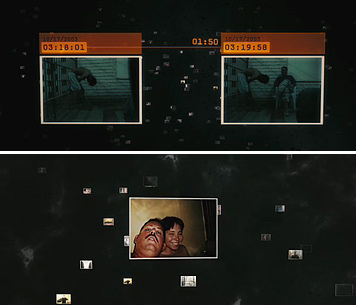
Still from Abu Ghraib reenactment scene, Standard Operating Procedure, 2008
In Sontag & Kael: Opposites Attract Me, Craig Seligman writes of Susan Sontag and her collection On Photography: "She's profoundly troubled by certain ethical and aesthetic issues arising from the mechanical nature of the medium, such that a more accurate title for the book might be On Some Problems in Photography." I mention this quip because I was reminded of it last week, as I sat nervously in the tiny "Cinémathèque" at Brandeis University in Boston after a screening of Errol Morris's new documentary, Standard Operating Procedure.
During the Q&A session following the film, which is comprised partly of interviews with five of the "seven bad apples" who were prosecuted in connection with the famous photos taken of the abuses afflicted on prisoners at Abu Ghraib, Morris said that one of his chief reasons for beginning the project was to explore "some of the problems I have with photography." And despite having recently spent 25,000 words on his The New York Times blog disputing a toss-off claim Sontag once made that a famous war photograph was staged, Morris clearly shares with her a certain obsession with, and anxiety about, the implications of the medium.
Standard Operating Procedure is a gorgeous, pulsing stopwatch of a movie, and like all of Morris's best work, its structure is based on a rhythmic series of revelations. As in the Eameses' Powers of Ten, he starts with what we think we know about his subjects, then systematically, incrementally zooms out, putting our understanding in a larger context, then inverts his gaze, revealing the clockwork beneath. He is regarded widely as a master interviewer, having invented the hyped 'Interrotron', but likely the truth is that he's a tireless interviewer and a master editor; he cuts to a musical beat, infusing the quirks and ticks of his subjects' personalities with a haze of suspense.
In the last decade, Morris has become increasingly insistent on putting his audiences face-to-face with morally repulsive people, to the point that most of us would pay good money to ensure we'd never be stuck in a room with them. I will go as far as to say that his three most recent movies, Mr. Death, The Fog of War and Standard Operating Procedure, could be regarded as a trilogy of slimy characters, the former two dealing with Fred Leuchter, a death penalty specialist popular on the Holocaust-denial circuit, and Robert McNamara, a denier of another sort. Morris's motives differ in each case, to be sure, but he is nonetheless determined to have us empathize with people who disgust us. He doesn't attempt to extract apologies from them, per se. But at least one of his goals in these movies is to give these villains, whom we have branded and brushed under the rug, a chance to explain themselves — a prospect which may have us asking whether we think they deserve that chance.
It becomes apparent fairly quickly, though, in Standard Operating Procedure that the soldiers interviewed here are not the one-dimensional monsters we may have come to expect from seeing them in photographs. They are guilty of atrocities, yes, but their feelings about their complicity in those atrocities are complex and often contradictory, a mixture of guilt and indignation. All of them seem genuinely surprised they ever became involved in this episode, and righteously know they are scapegoats — an arbitrary handful of guilty parties singled out as responsible for a larger phenomenon, prosecuted not because they committed these acts, but because they photographed themselves doing so.
In this month's Artforum, Paul Arthur took Morris to town for using reenactments and a haunting, Philip Glass-ish score from Danny Elfman to amp up the film's drama. "To employ this rhetoric in a documentary about actual horror," Arthur writes, "is obscene, yielding familiar aesthetic thrills as a substitute for specificity of meaning." But the reenactments, though illustrative and gruesome, are obviously not meant to be Errol Morris's version of what actually happened: they are at least partially presented as further examples of photography's tendency to conceal and deceive. Arthur alternately attacks Morris because Abu Ghraib is ground already covered, and because Standard Operating Procedure does not cover that ground in the same all-encompassing way as have previous efforts on the topic. Zeroing in on the composition and context of the photos is, in Arthur's view, an effort ultimately made in vain, pointless and perhaps even reckless. But to question the moral compass of a man who made The Thin Blue Line, the only movie to successfully liberate an innocent man from death row, strikes me as absurd. Is the subject matter in this film too bluntly taboo to not tackle reverently or somberly? What's wrong with eschewing some of what we already know about Abu Ghraib to shine some light on the photos of which we are all so familiar?

Stills of graphics sequences designed by Kyle Cooper and Prologue Films, Standard Operating Procedure, 2008
In a marked improvement on the poor screen typography of The Fog of War, Kyle Cooper was employed to give Standard Operating Procedure its title sequence and the full graphic work-over. And so we have, next to Morris's interviews and reenactments, a third main character: the choreographed presentation of the Abu Ghraib photos themselves. All of us have seen some of these, but who of us have seen all of these? They number in the thousands, and to illustrate their abundance, Cooper, along with his studio Prologue, has widely dispersed them through vast three-dimensional space. The camera pans in, out, and all around them, and occasionally, to illustrate a point being made by Criminal Investigator Brent Pack, they gather together in a tight grid and align to match their described relationships, or dissolve to reveal a barrage of numbers and symbols, the hidden meta-data of date and time within the digital files. And so we walk away from this film knowing not only more about the content and context of these photos, but also knowing what kinds of digital cameras they were taken with, and how the data embedded in them ultimately provided the evidence that was needed to convict the photographers.
Morris takes an artist's view of the Abu Ghraib photographs and their inhabitants. His interest in photography has led him to a set of iconic images that exposed a nation to its own worst behavior, and at the same time provided a cover for those most implicit in it to duck behind. He subjects them to a full circumstantial and aesthetic investigation, and uses them as the backdrop for his riskiest and most topical film to date. He will thus continue to be chided for straying from the self-congratulatory stoicism that characterizes the dirge of Iraq documentaries that are released each year — all more purely "documentary" than his. But with luck, Errol Morris will transfer some of his own uneasiness about photography and its many possible interpretations to his audience, and we will think twice when confronted by the future images, horrific and bold, of this American war.
Teddy Blanks is a senior designer at Winterhouse Studio, and a contributor to the online film magazine, Not Coming To A Theater Near You, where he recently completed a feature on monologist Spalding Gray. His band, the Gaskets, has released two albums.
